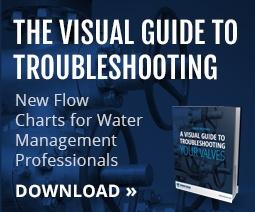
This article originally appeared in the November 2016 issue of Water & Wastes Digest.
As automation and computers claimed a foothold in the operation and control of reservoirs and elevated water tanks, the industry moved the valve control from mechanical automatic control valves (ACV) to actuated butterfly and ball valves. The primary reason? Actuators can be controlled by SCADA systems, which have been almost universally implemented in modern water systems. Because of this, many water system managers and operators have stopped purchasing the mechanical altitude valve which was the standard for many years.
What is an Altitude Valve?
An altitude valve is a mechanical valve that uses a sensing line from the reservoir or tank to a highly sensitive pilot, that allows the valve to open or close to maintain a user set level of the water. Altitude valves can be designed to open once the water level begins to drop, usually around 1 to 2 feet (0.3m to 0.6m), or can be equipped to allow for a user to adjust draw-down of the water level to allow for more tank or reservoir turn-over.
Altitude valves are still used when a tank or reservoir location has no power or when getting power to the location is extremely costly. They are also better suited for cold climates where a top layer of ice in a reservoir can interfere with the electronic measurement. For smaller water suppliers that do not have the budget to implement a SCADA system, a mechanical altitude valve is still the best option.
Figure 1: Typical Altitude Valve & Installation

How Do Automatic Control Valves Work?
All diaphragm automatic control valves work on the same principle — using a rubber diaphragm to separate the upper control chamber from the actual water moving through the valve when it is operational. By controlling the water either going into or leaving the control chamber, the valve can be opened fully, closed drip tight or modulated into any position in between.
Figure 2: Control Valve showing the upper control chamber

What are the Advantages of an ACV?
The first key advantage is that ACVs are designed to modulate and control water at all varying flows while butterfly valves were originally designed to be an open or closed valve. The advent of an actuator allowed a butterfly valve to be modulated, but this is not what the butterfly valve was truly designed to do. Butterfly valves and ball valves that are only opened a little bit are prone to cavitate — and nothing much can be done to stop or control this.
Many ACV manufacturers also have an option for an anti-cavitation trim, which can occur in level control valves when a large inlet pressure is supplied by the system. As a general rule of thumb, any time the inlet pressure is more than three times higher than the reservoir tank’s head pressure (which creates back pressure), the valve will cavitate. This cavitation can significantly damage the valve, as well as create a lot of noise and vibration. ACVs equipped with an engineered anti-cavitation trim can stop all cavitation damage as well as quiet the valve and reduce vibration.
Almost all ACVs can be serviced in line without removing them from the line where they are installed. This allows for a faster service with less downtime — which is great given keeping the system in operation as much as possible is key.
Costs for ACVs are generally higher than those associated with using actuated butterfly or ball valves. But while using three-phase power to run an electric actuator can be expensive, the cost of a compressor with air lines for a pneumatic actuator is the same. ACVs do not require these additional costs. In the event of a power failure, battery backups for the actuators are an additional expense.
ACVs have the ability to easily add more features to the pilot system that make the valve more flexible. It is inexpensive to add a pressure-sustaining feature, or rate-of-flow feature to a mechanical ACV.
Electronic Control of ACVs
In the past, all automatic control valves have been controlled and operated using a mechanical pilot, which is a proven and reliable technology, but in today’s water systems, having control and feedback through the SCADA system is a desired feature. This is the main reason water system managers and consultants changed over to electrically or pneumatically controlled butterfly valves. But this is not the case anymore. Most automatic control valve manufacturers have now adapted their ACVs to be operated and controlled electronically.
There are a few different ways, but the most common is to install solenoid valves into the pilot system that controls the water flowing into and out of the control chamber. There is one solenoid valve that, when opened for a controlled amount of time, allows water into the control chamber and begins to close the valve. The second solenoid valve, when open for a controlled amount of time, allows water to come out of the control chamber and, in turn, opens the ACV by a certain amount.
By controlling how much water either moves into or out of the control chamber, the valve can be opened, closed or modulated. These solenoid control valves can be pulsed open and closed as much as the user wants to have the valve open or closed, or to adjust the opening of the ACV to a precise position. All that is required is a controller (stand-alone PLC or SCADA controller) with a feedback sensor to the controller. The controller then gets feedback from a level sensor and makes adjustments to the ACV by pulsing the solenoids to open or close the valve.
Figure 3: Electronic Controlled ACV

Additional Options for Increased Confidence
Having electronic control allows for excellent regulation and feedback of an ACV, but during a power failure or outage this all changes. With battery backups, the ACVs and actuated butterfly valves can be programmed to close fully, open fully or maintain the last position — but this can have significant side effects. If the valve is programmed to close during a power failure, the tank or reservoir will not be filling during the entire outage — so the tank would either drain very low or drain completely if the power outage lasts too long.
If the valve is left open, the tank would overflow and a significant amount of water would be lost — which wastes both money and precious resources.
Unlike the actuated butterfly valve, an ACV (which is electronically controlled as shown in Figure 3) can also have a standard mechanical level control pilot (altitude pilot) added to the valve as a backup in the case of a power failure. This way, the valve would not need to be open or closed, but could be controlled by the mechanical pilot and allow the tank to keep filling and then shut off when the desired level is reached. In other words, it’s the best of both worlds and ensures the system is working at its optimum — even during power supply issues at the tank or reservoir location.
Summary
As the water supply industry continues to move to electronic control, using an automatic control valve equipped with electronic solenoids is a better option for level control of tanks and reservoirs. By adding a mechanical backup pilot system to control during power failures or outages, the system can continue to work and maintain optimum water levels. In the event cavitation could occur, adding an anti-cavitation trim makes the automatic control valve a versatile option for long-lasting level control and guaranteed backup.








